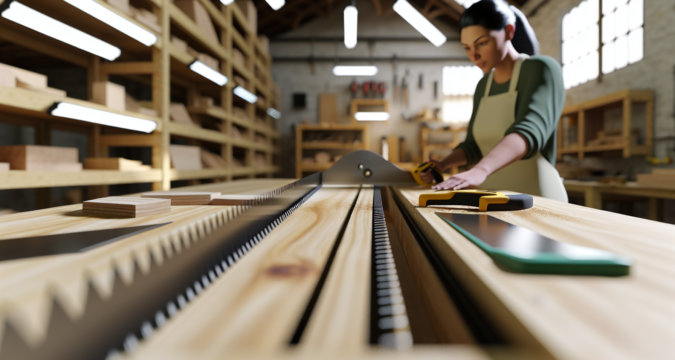
Join us on this comprehensive journey to explore the art of crosscuts and discover how they shape the world of woodworking. Imagine embarking on your first woodworking project, eager to transform a raw piece of wood into a beautiful creation. As you delve into the world of joinery, you’ll encounter a fundamental technique called crosscutting—a cut made perpendicular to the grain of the wood.
Key Takeaway:
| Crosscuts are essential for dividing boards, creating joints, and trimming excess material in woodworking. |
| Understanding different types of crosscuts, including straight, angled, and compound, is crucial for precise cuts. |
| Proper tool selection and safety precautions ensure accurate and safe crosscutting. |
| Mastering crosscutting techniques opens up a wide range of woodworking applications, from furniture to intricate designs. |
Understanding Crosscuts:
Crosscuts serve as the foundation for various woodworking projects. They allow you to: – Cut boards to specific lengths, creating components for furniture, cabinets, and picture frames. – Create joints, such as butt joints and dado joints, to securely assemble wood pieces. – Trim excess material, ensuring a clean and finished look for your projects.
Essential Tools for Crosscutting:
The right tools are vital for precise and efficient crosscuts. Here’s what you need: – Saws: Choose the appropriate saw for your project and material. Consider hand saws for detailed work and power saws like circular saws or miter saws for larger projects. – Measuring Tapes and Squares: Accurate measurements are key. Use measuring tapes and squares to mark precise cutting lines. – Clamps: Secure your workpiece firmly with clamps to prevent movement and ensure a clean cut.
Techniques for Making Crosscuts:
- Measure and Mark: Accurately measure and mark the desired cutting line using a measuring tape and a pencil.
- Secure the Workpiece: Clamp the workpiece securely to a stable surface to prevent movement.
- Adjust Saw Settings: Set the saw’s depth and angle according to the required cut.
- Make the Cut: Guide the saw along the marked line, applying steady pressure to achieve a clean cut.
Common Mistakes and Solutions:
- Inaccurate Measurements: Double-check your measurements and markings to ensure precision.
- Improper Saw Selection: Choose the right saw for the task. A hand saw may be better suited for intricate cuts, while a power saw can handle larger projects efficiently.
- Incorrect Saw Blade: Select the appropriate saw blade for the material you’re cutting. A fine-tooth blade is ideal for clean cuts in wood, while a coarse-tooth blade is better for rough cuts.
Applications of Crosscuts in Woodworking:
Crosscuts are versatile and find applications in numerous woodworking projects: – Furniture Making: Crosscuts are used to create components for tables, chairs, cabinets, and more. – Joinery: Crosscuts enable the creation of various joints, such as butt joints and dado joints, to securely assemble wood pieces. – Decorative Elements: Crosscuts can be used to create intricate designs, patterns, and decorative edges.
Safety Precautions for Crosscutting:
- Wear Safety Gear: Always wear eye protection, ear protection, and a dust mask to protect yourself from flying debris and harmful dust particles.
- Use Sharp Blades: Ensure that your saw blades are sharp to achieve clean cuts and reduce the risk of accidents.
- Maintain a Clean Workspace: Keep your workspace organized and free of clutter to prevent tripping hazards.
Conclusion:
Crosscuts are a fundamental technique in woodworking, opening up a world of possibilities for creating beautiful and functional projects. With practice and attention to detail, you’ll master the art of crosscutting and elevate your woodworking skills to new heights. Embrace the challenge and embark on your woodworking journey today!
FAQs:
What is the difference between a rip cut and a crosscut? A rip cut is made parallel to the grain of the wood, while a crosscut is made perpendicular to the grain.
How to choose the right saw for crosscutting? Consider the project, material, and desired precision. Hand saws offer more control for detailed cuts, while power saws like circular saws or miter saws can handle larger projects efficiently.
What are the techniques for making accurate crosscuts? Accurate measurements, proper saw selection, and steady cutting techniques are essential for precise crosscuts.
How to avoid common mistakes when making crosscuts? Double-check measurements, choose the right saw and blade for the task, and secure the workpiece firmly.
What are the different applications of crosscuts in woodworking? Crosscuts are used in furniture making, joinery, and creating decorative elements.
How to ensure safety when making crosscuts? Wear safety gear, use sharp blades, and maintain a clean workspace to prevent accidents.
Where can I find more information about crosscuts and woodworking? Woodworking Finishes: Choosing the Right Finish for Your Project Woodworking Finishing for Different Project Types Common Woodworking Mistakes
Embark on your woodworking journey with confidence, knowing that you have the skills and knowledge to make precise crosscuts that will elevate your projects to the next level.
Below are three external links that could be relevant to this article:
How to Make Crosscuts in Woodworking – A Beginner’s Guide This YouTube video provides a step-by-step tutorial on making crosscuts in woodworking, covering essential techniques and safety precautions.
Crosscutting in Woodworking This comprehensive article from Woodcraft discusses the basics of crosscutting, including different types of crosscuts, tool selection, and safety tips.
How to Make Crosscuts with a Circular Saw This detailed guide from Family Handyman focuses on using a circular saw for crosscutting, providing instructions, safety tips, and troubleshooting advice.

